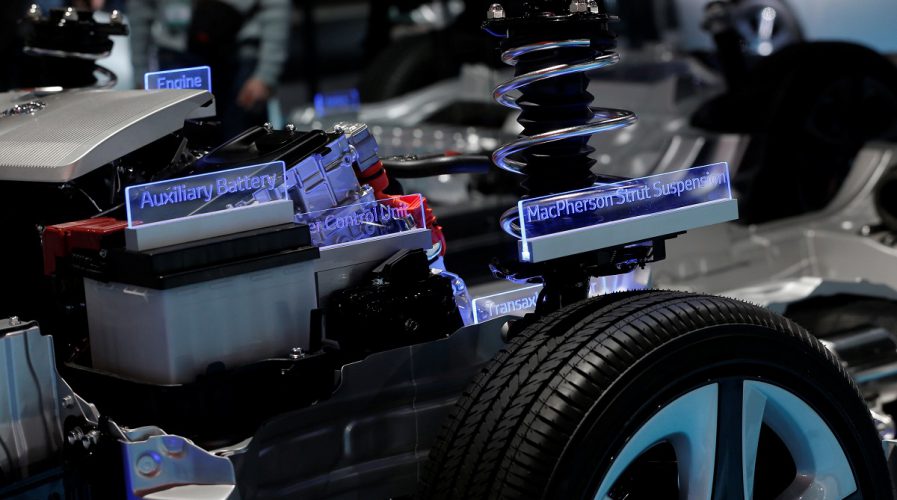
Cutaway view of a Toyota Prius Hybrid being displayed at the North American International Auto Show in Detroit. Pic: Reuters
Toyota unlocks its engine technology, could sell to rivals
LONG guarded about what was beneath the hood of its pioneering Prius cars, Toyota Motor Corp. plans to open up its powertrain technology to rivals, hoping this will boost sales and speed up the industry’s shift to lower-emission vehicles.
Announcing last week it would expand its gasoline hybrid technology development, the world’s largest automaker said it would consider selling complete powertrain modules – engines, transmissions and other drive components – to its competitors.
The prospect of giving rivals access to “one-size-fits-all” powertrains comes as cars are increasingly dependent on computerized components, making it easier to design similar parts across model ranges. The industry has moved on from competing largely on mechanical engineering.
Toyota tech keeps driver in seat with hands off wheel https://t.co/qZAgaeDiUb
Hava SUA n see how this works? ?— Francine Lawler (@04Francene) December 10, 2016
That trend will likely accelerate as automakers face pressure from regulators to further cut car emissions and develop more long-range electric vehicles.
As cars become more like glorified computers, automakers are standardizing many mechanical parts and competing more on style and packaging – giving drivers a bigger range of features from automated parking to cockpit concierges.
For Toyota, this is a big departure from having a tightly-knit network of suppliers keeping much of their jointly developed technology exclusive so as to have an engineering competitive edge on rivals.
“Toyota suppliers produce a lot of technology which can only be used by Toyota,” Toshiyuki Mizushima, president of Toyota’s powertrain company, told reporters. “We want to change that to a system where we develop technology with our suppliers at an earlier stage … so they can make that technology available to non-Toyota customers.”
SEE ALSO: Toyota’s new battery technology could upgrade cruise range in hybrid vehicles
Mizushima, who joined Toyota a year ago from group company Aisin Seiki Co, noted, for example, that past versions of Toyota’s hybrid system didn’t fit other automakers’ cars, limiting suppliers’ options to sell to non-Toyota customers.
Powertrains combine parts often made separately by several independent parts makers, but Toyota’s are unique in that they are made by its group suppliers, allowing engineers at the automaker and its suppliers to collaborate in development.
“Until now, we couldn’t sell the same inverter used in Toyota’s previous hybrid system to other customers because it wouldn’t fit the motor, or the voltage was different,” said Yoshifumi Kato, executive director of engineering R&D at Denso Corp, Toyota’s biggest supplier.
Toyota to expand hybrid system development to further cut emissions – Reuters https://t.co/0XAdXfuJEc #Technology
— Tech News (@technews_google) December 6, 2016
“We can avoid this issue if suppliers can sell the entire system.”
The move should help auto parts companies such as Denso and Aisin spread their customer base and compete better against global rivals including Robert Bosch and Continental . Currently, Toyota accounts for around half the annual sales at Denso and Aisin.
SPREADING THE R&D BURDEN
Mizushima said he would like to see Toyota offer its powertrain modules to all its rivals, in an industry where more automakers are setting up exclusive tie-ups on parts.
Nissan Motor Co this year launched the Infiniti QX30 luxury compact crossover using engines and other parts developed and made by Daimler AG’s Mercedes and its suppliers. Toyota already shares components for Fuji Heavy Industries Ltd’s Subaru BRZ sports car under a joint development agreement.
SEE ALSO: Toyota chief shifts gear, to boost electric vehicle division
In opening up its proprietary technology, Toyota is acknowledging the escalating costs of R&D, as global automakers vie to develop hybrid and all-electric cars, self-driving cars and cars connected to mobile technology.
Toyota’s R&D spend last year was 73 percent more than in 2010 at around US$9 billion, while spending at Volkswagen , its biggest competitor, more than doubled over the same period.
As automakers are having to invest more, they are cramming as much technology as possible into each vehicle, while limiting price increases. Toyota and its suppliers expect their newer production platform will mean making a lot more of fewer common parts across its models, and selling them to other automakers to earn back more of the money spent on R&D.
#truthhertz Can't stress the importance of ecofriendly tech enough. Toyota’s New EV Division Headed By Company … https://t.co/FllvPOcdOM
— rebirth of rennisanc (@rebirthofrennis) December 4, 2016
“If we take a component developed with Toyota and sell a million to Toyota and another million to other customers, it would double our return on our development costs,” said Denso’s Kato.
Toyota’s rivals, too, should be able to keep their own development and procurement costs down if they can source off-the-shelf from Toyota, say industry consultants.
“It could be a win-win for Toyota and its rivals because Toyota could develop another sales line, while customers could gain access to components which may be cheaper and of higher quality than the same parts developed in-house,” said Takeshi Miyao, Asia managing director at Carnorama. – Reuters
READ MORE
- The criticality of endpoint management in cybersecurity and operations
- Ethical AI: The renewed importance of safeguarding data and customer privacy in Generative AI applications
- How Japan balances AI-driven opportunities with cybersecurity needs
- Deploying SASE: Benchmarking your approach
- Insurance everywhere all at once: the digital transformation of the APAC insurance industry
